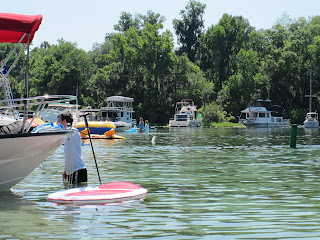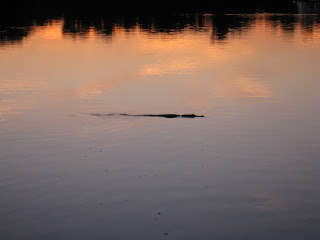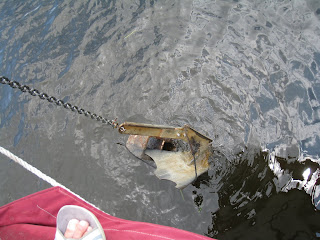We stopped a few hours later at Hontoon Island State Park (where we had spent three nights on the way upstream) since we enjoyed that area so much. We had thought we might stop at Blue Springs Park on the way, but when we looked at the only two anchorages available we decided to bypass that park this trip. The stop at Hontoon Island State Park turned out to be an interesting one. Late in the afternoon as we were sitting topside reading we saw a strange looking bird swimming toward the island; it took a while to realize it was a juvenile sand hill crane apparently not yet able to fly swimming through the alligator-infested waters to join its parents on the island! We see sand hill cranes almost daily at our home, but had never seen one swimming. Quite an unusual site. Then, shortly after sunset, the alligators began appearing. One was obviously much larger than the others and cruised both sides of the river and then entered the area around the docks at the island where it apparently threatened a smaller 'gator which quickly swam away. Good thing the sand hill crane had made it to shore well before the 'gators started their nightly patrol.
The next day we continued downstream (north) to the southern end of Lake George and then turned left off the main channel to anchor near the entrance to Crystal Glen Spring Run, one of the many fresh water springs in central Florida. The afternoon was hot, and we didn't waste much time after anchoring getting the dinghy into the water and motoring into the spring. As soon as we got near the spring's mouth the water got clear and cooler, and after actually entering the spring we could easily see the bottom, fish swimming around, and aquatic plants of various kinds.

 The spring originates about 3/4 of a mile to the west of Lake George's shoreline, and near the actual spring the body of water gets a little wider with a roped-off state park at the far end. Boats of all descriptions were anchored in the very shallow area just before the source while others were pulled up on the sandy shoreline. There were a number of small house boats, kayaks, canoes, small runabouts, and various types of pontoon boats - even a guy selling hot dogs and sodas from a pontoon boat which he would frequently motor around the other boats. People were in the water talking and swimming and generally enjoying the cool spring water. As we were leaving we saw one large gar perhaps 3 feet long as well as other fish of unknown types.
The spring originates about 3/4 of a mile to the west of Lake George's shoreline, and near the actual spring the body of water gets a little wider with a roped-off state park at the far end. Boats of all descriptions were anchored in the very shallow area just before the source while others were pulled up on the sandy shoreline. There were a number of small house boats, kayaks, canoes, small runabouts, and various types of pontoon boats - even a guy selling hot dogs and sodas from a pontoon boat which he would frequently motor around the other boats. People were in the water talking and swimming and generally enjoying the cool spring water. As we were leaving we saw one large gar perhaps 3 feet long as well as other fish of unknown types.  That evening the wind suddenly picked up from less than 5 mph to around 15-17 mph from the south-east as we began hearing thunder in the distance. Eventually we could see the lightning in the clouds as the sun was still setting, and soon it became obvious that we were on the edge of a large thunderstorm. NOAA weather radio indicated that a severe storm was heading south - and it did as it skirted just to the west of the lake. Eventually the storm passed and the wind calmed down to nearly nothing.
That evening the wind suddenly picked up from less than 5 mph to around 15-17 mph from the south-east as we began hearing thunder in the distance. Eventually we could see the lightning in the clouds as the sun was still setting, and soon it became obvious that we were on the edge of a large thunderstorm. NOAA weather radio indicated that a severe storm was heading south - and it did as it skirted just to the west of the lake. Eventually the storm passed and the wind calmed down to nearly nothing.Saturday morning we departed Silver Glen Springs Run and ran 37 miles to Porters Cove, about three miles south of Palatka, where we anchored for the night. We dinghied downstream 1.5 miles to the free restaurant dock at Corky Bell's Restaurant where we met friends for dinner, and were back on Sanderling (again via dinghy) before sunset. The air was still and hot enough that we ran the generator and both air conditioning units until about 0100 the next morning in order to keep cool enough to sleep comfortably.

 On Sunday we had planed to travel as far as the free restaurant dock on Six Mile Creek, just south of Green Cove Springs, to spend the night; however, due to the hot weather with temps approaching 95 we decided to stop for a late lunch at the Outback Crab Shack restaurant and continue north to Naval Air Station Jacksonville where we could be in an inexpensive marina with electricity for air conditioning. We're glad we made that choice. The temps have been in the mid to high 90s with humidity to match, making a heat index near 105 for the past several days!
On Sunday we had planed to travel as far as the free restaurant dock on Six Mile Creek, just south of Green Cove Springs, to spend the night; however, due to the hot weather with temps approaching 95 we decided to stop for a late lunch at the Outback Crab Shack restaurant and continue north to Naval Air Station Jacksonville where we could be in an inexpensive marina with electricity for air conditioning. We're glad we made that choice. The temps have been in the mid to high 90s with humidity to match, making a heat index near 105 for the past several days!Judy is driving home Tuesday evening to work in her hospital on Wednesday. While she's away, Bob is going to try to fix, at least temporarily, the aft cabin air conditioner which seems to have it's own rules about the best time to run and rest. When Judy returns on Thursday morning we'll depart for a Jacksonville and a few nights at the Landing so we can do some more sight-seeing for a day. Then we'll head into the ICW and south toward Merritt Island and home.
































